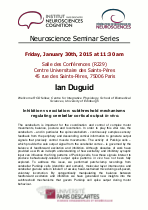Neuroscience Seminar Series,
Friday, January 30, 2015 at 11:30 am
Salle des Conférences, Centre Universitaire des Saints-Pères, 45 rue des Saints-Pères, 75006 Paris
Ian Duguid, Wellcome RCD Fellow, Centre for Integrative Physiology, School of Biomedical Sciences, University of Edinburgh
 Inhibition vs excitation: subthreshold mechanisms regulating cerebellar cortical output in vivo
Inhibition vs excitation: subthreshold mechanisms regulating cerebellar cortical output in vivo
The cerebellum is important for the coordination and control of complex motor movements, balance, posture and locomotion. In order to play this vital role, the cerebellum ‒ and in particular the spinocerebellum – continuously samples sensory feedback from the periphery and descending cortical information to generate output signals that precisely control muscle movements. The activity of Purkinje cells ‒ which provide the sole output signal from the cerebellar cortex ‒ is governed by the balance of feedforward excitation and inhibition. Although decades of work have provided us with an in-depth understanding of how excitatory and inhibitory synaptic input can influence the firing patterns of Purkinje cells, how these signals interact to produce behaviourally-relevant output spike patterns in vivo has not been fully explored. To address this issue, we performed patch-clamp recordings from cerebellar Purkinje cells (dendritic and somatic), molecular layer interneurons and cerebellar granule cells in lobule V of awake, head-restrained mice during self-paced, voluntary locomotion. By optogentically manipulating the balance between feedforward excitation and inhibition we have generated new insights into the subthreshold mechanisms that govern Purkinje cell spike output during motor behaviour.
